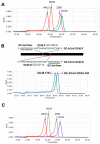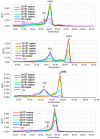A Melting Curve-Based Multiplex RT-qPCR Assay for Simultaneous Detection of Four Human Coronaviruses
- PMID: 27886052
- PMCID: PMC5133880
- DOI: 10.3390/ijms17111880
A Melting Curve-Based Multiplex RT-qPCR Assay for Simultaneous Detection of Four Human Coronaviruses
Abstract
Human coronaviruses HCoV-OC43, HCoV-229E, HCoV-NL63 and HCoV-HKU1 are common respiratory viruses associated with acute respiratory infection. They have a global distribution. Rapid and accurate diagnosis of HCoV infection is important for the management and treatment of hospitalized patients with HCoV infection. Here, we developed a melting curve-based multiplex RT-qPCR assay for simultaneous detection of the four HCoVs. In the assay, SYTO 9 was used to replace SYBR Green I as the fluorescent dye, and GC-modified primers were designed to improve the melting temperature (Tm) of the specific amplicon. The four HCoVs were clearly distinguished by characteristic melting peaks in melting curve analysis. The detection sensitivity of the assay was 3 × 10² copies for HCoV-OC43, and 3 × 10¹ copies for HCoV-NL63, HCoV-229E and HCoV-HKU1 per 30 μL reaction. Clinical evaluation and sequencing confirmation demonstrated that the assay was specific and reliable. The assay represents a sensitive and reliable method for diagnosis of HCoV infection in clinical samples.
Keywords: SYTO 9; human coronaviruses; melting curve; melting temperature (Tm); multiplex quantitative RT-PCR (RT-qPCR).
Conflict of interest statement
The authors declare no conflict of interest.
Figures



Similar articles
-
Genetic variability of human coronavirus OC43-, 229E-, and NL63-like strains and their association with lower respiratory tract infections of hospitalized infants and immunocompromised patients.J Med Virol. 2006 Jul;78(7):938-49. doi: 10.1002/jmv.20645. J Med Virol. 2006. PMID: 16721849 Free PMC article.
-
Epidemiology and clinical characteristics of human coronaviruses OC43, 229E, NL63, and HKU1: a study of hospitalized children with acute respiratory tract infection in Guangzhou, China.Eur J Clin Microbiol Infect Dis. 2018 Feb;37(2):363-369. doi: 10.1007/s10096-017-3144-z. Epub 2017 Dec 6. Eur J Clin Microbiol Infect Dis. 2018. PMID: 29214503 Free PMC article.
-
Coronavirus HKU1 and other coronavirus infections in Hong Kong.J Clin Microbiol. 2006 Jun;44(6):2063-71. doi: 10.1128/JCM.02614-05. J Clin Microbiol. 2006. PMID: 16757599 Free PMC article.
-
An overview on the seven pathogenic human coronaviruses.Rev Med Virol. 2022 Mar;32(2):e2282. doi: 10.1002/rmv.2282. Epub 2021 Aug 2. Rev Med Virol. 2022. PMID: 34339073 Review.
-
[Coronaviruses as the cause of respiratory infections].Internist (Berl). 2019 Nov;60(11):1136-1145. doi: 10.1007/s00108-019-00671-5. Internist (Berl). 2019. PMID: 31455974 Free PMC article. Review. German.
Cited by
-
Reducing False Negative PCR Test for COVID-19.Int J MCH AIDS. 2020;9(3):408-410. doi: 10.21106/ijma.421. Epub 2020 Oct 8. Int J MCH AIDS. 2020. PMID: 33072432 Free PMC article.
-
Analytical performances of different diagnostic methods for SARS-CoV-2 virus - A review.Sens Int. 2022;3:100197. doi: 10.1016/j.sintl.2022.100197. Epub 2022 Jul 30. Sens Int. 2022. PMID: 35935464 Free PMC article. Review.
-
Next-generation molecular diagnostics: Leveraging digital technologies to enhance multiplexing in real-time PCR.Trends Analyt Chem. 2023 Mar;160:116963. doi: 10.1016/j.trac.2023.116963. Epub 2023 Feb 9. Trends Analyt Chem. 2023. PMID: 36968318 Free PMC article.
-
In pursuit of COVID-19 surgical risk stratification to manage a limited workforce and supplies in minimally invasive surgery.Wideochir Inne Tech Maloinwazyjne. 2020 Sep;15(3):416-423. doi: 10.5114/wiitm.2020.95073. Epub 2020 May 10. Wideochir Inne Tech Maloinwazyjne. 2020. PMID: 32904725 Free PMC article. Review.
-
South Indian medicinal plants can combat deadly viruses along with COVID-19? - A review.Microb Pathog. 2020 Nov;148:104277. doi: 10.1016/j.micpath.2020.104277. Epub 2020 May 28. Microb Pathog. 2020. PMID: 32473390 Free PMC article.
References
-
- Woo P.C., Lau S.K., Chu C.M., Chan K.H., Tsoi H.W., Huang Y., Wong B.H., Poon R.W., Cai J.J., Luk W.K., et al. Characterization and complete genome sequence of a novel coronavirus, coronavirus HKU1, from patients with pneumonia. J. Virol. 2005;79:884–895. doi: 10.1128/JVI.79.2.884-895.2005. - DOI - PMC - PubMed
MeSH terms
Substances
LinkOut - more resources
Full Text Sources
Other Literature Sources
Molecular Biology Databases
Miscellaneous

